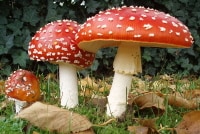A classification of 14 syndromic categories of mushroom poisoning has been proposed, but this classification system has yet to be widely adopted.[4, 5]
Mushrooms in the ibotenic acid group are commonly found throughout the United States, Europe, and Asia. They are found in wooded areas, especially among conifer forests, in the spring and fall seasons of North America. The young specimens emerge with patches of membrane left covering the cap and forming a cup (volva) at the base. The mature specimens often have brilliant cap colors and delicate skirts and cups. Many everyday representations of mushrooms depict the A muscaria because of its shape and bright coloring.
- Tämän ryhmän sienien edustaja on PUNAKÄRPÄSSIENI kirkkaan punaisine hattuineen.
 Amanita muscaria.
Amanita muscaria. Mushroom poisoning in children is an infrequent but perennial problem for parents and clinicians. Parental anxiety is generally high because of fears of unknown or untoward effects. Clinicians are challenged to identify such poisonings, to discern whether poisoning has taken place, to order appropriate diagnostic studies, and to prescribe reasonable therapy. The varied nature of mushroom toxicities, their ubiquitous distribution, and the relative infrequency of the ingestions make the task difficult.
Dried mushrooms have been promoted on the Internet because of their various properties, and their ingestion might lead to serious toxicity from the mushroom or from unknown adulterants added to them.[6]
Various cultures throughout the world have used fungi for ceremonies and for divinatory purposes, practices that date back 3000 years. In North America, the Algonquin people used A muscaria for religious and ritualistic ceremonies. In some European and Asian cultures, the urine of a person or a deer ingesting these mushrooms is consumed to achieve secondary intoxication.
WIKIPEDIATIETO
http://en.wikipedia.org/wiki/Ibotenic_acid
- Iboteenihapon kaava. Iboteenihappoa käytetään aivoleesion aiheuttajana kokeellisessa tieteellisessä tutkimuksessa.
Muscimol (agarin, pantherine) is the major psychoactive alkaloid present in many mushrooms of the Amanita genus. Unlike psilocybin, a tryptamine, muscimol is a potent, selective agonist of the GABAA receptor.
http://en.wikipedia.org/wiki/Muscimol
When ibotenic acid is ingested, a small portion is decarboxylated into muscimol. Ibotenic acid evokes entheogenic effects in human beings at doses in range of 50-100 mg.[4] Peak intoxication is reached approximately 2-3 hours after oral ingestion,[5] consisting of one or all of the following; visual distortions/hallucinations, loss of equilibrium, muscle twitching (commonly mislabeled as convulsions), and altered sensory perception. These effects generally last for 6-8 hours, varying with dose.[6]
- Muskimolin lisäksi A. muscariassa esiintyy muskariinia, parasympaattisesti vaikuttavaa molekyyliä, joka muistuttaa asetyylikoliinin ( muskariinin) kaltaisia vaikutuksia.
Muskariinin avulla on jopa luokiteltu Asetylkoliinireseptoreita tieteellissti ihmisestä:
Mitä sienimyrkytykseen tulee, tästä komponentista tulee suurta limaneritystä.
Inga kommentarer:
Skicka en kommentar